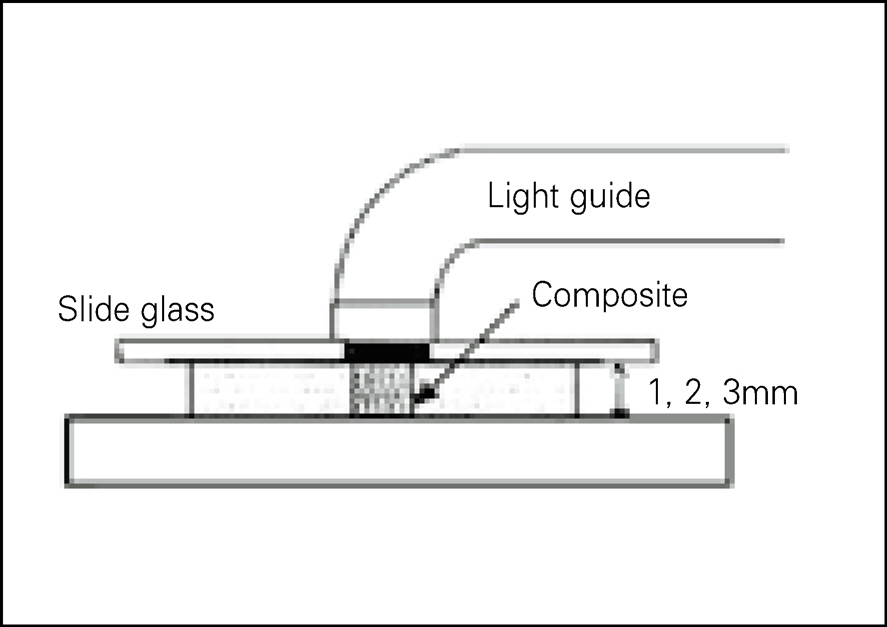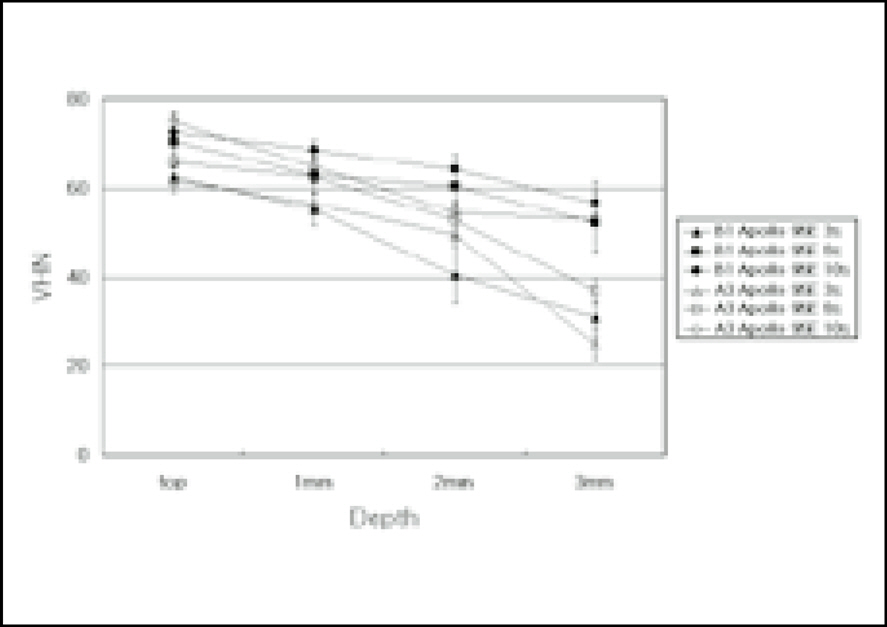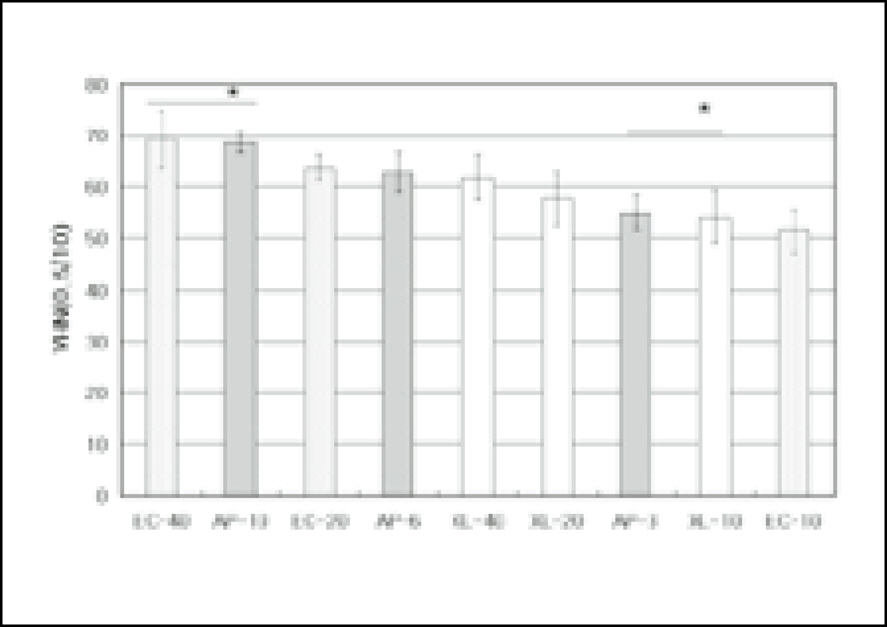Articles
- Page Path
- HOME > Restor Dent Endod > Volume 27(6); 2002 > Article
- Original Article EFFECT OF LIGHT SOURCE AND SHADE ON DEPTH OF CURE OF COMPOSITES
- Joon-Sok Na, Sun-Wa Jeong, Yun-Chan Hwang, Sun-Ho Kim, Chang Yun, Won-Mann Oh, In-Nam Hwang
-
J Korean Acad Conserv Dent 2002;27(6):-568.
DOI: https://doi.org/10.5395/JKACD.2002.27.6.561
Published online: January 14, 2002
Dept. of Conservative Dentistry, College of Dentistry, DSRI, Chonnam National University
Dept. of Dentistry, College of Medicine, Seonam University
Copyright © 2002 The Korean Academy of Conservative Dentistry
This is an Open Access article distributed under the terms of the Creative Commons Attribution Non-Commercial License (http://creativecommons.org/licenses/by-nc/3.0) which permits unrestricted non-commercial use, distribution, and reproduction in any medium, provided the original work is properly cited.
- 854 Views
- 6 Download
- 1 Crossref
Abstract
-
Purpose of this research is estimating polymerization depth of different source of light. XL 3000 for halogen light, Apollo 95E for plasma arc light and Easy cure for LED light source were used in this study. Different shade (B1 & A3) resin composites (Esthet-X, Dentsply, U.S.A.) were used to measure depth of cure. 1, 2, and 3 mm thick samples were light cured for three seconds, six seconds or 10 seconds with Apollo 95E and they were light cured with XL-3000 and Easy cure for 10 seconds, 20 seconds, or 40 seconds. Vicker's hardness test carried out after store samples for 24 hours in distilled water.Results were as following.
Curing time increases from all source of lights, curing depth increased(p<0.05).
Depth (that except 1mm group and 2mm group which lighten to halogen source of light) deepens in all groups, Vickers hardness decreased(p<0.05).
Vicker's hardness of A3 shade composite was lower in all depths more than B1 shade composites in group that do polymerization for 10 seconds and 20 seconds using halogen source of light(p<0.05), but group that do polymerization for 40 seconds did not show difference(p>0.05).
Groups that do polymerization using Plasma arc and LED source of light did not show Vicker's hardness difference according to color at surface and 1mm depth(p>0.05), but showed difference according to color at 2mm and 3mm depth(p<0.05). The results showed that Apollo 95E need more polymerization times than manufacturer's recommendation (3 seconds), and Easy cure need polymerization time of XL-3000 at least.
| Curing unit | Manufacturer | Light source | Tip Diameter |
|---|---|---|---|
| XL 3000 | 3M, U.S.A. | Halogen lamp | 12 mm |
| Apollo 95E | DMD, U.S.A. | Xenon lamp | 7.5 mm |
| Easy cure | ICS, U.S.A. | LED light | 8 mm |
| Light source | Curing unit | Time of i rradiation | Tested shade |
|---|---|---|---|
| Halogen | XL 3000 | 10, 20, 40sec | B1, A3 |
| Plasma arc | Apollo 95E | 3, 6, 10sec | B1, A3 |
| LED | Easy cure | 10, 20, 40sec | B1, A3 |
| Curing unit | Curing time | top | bottom | ||
|---|---|---|---|---|---|
| 1mm | 2mm | 3mm | |||
| 10s | 51.27(5.12) | 46.50(5.36) | 41.65(3.28) | 29.73(3.89) | |
| XL 3000 | 20s | 57.25(2.30) | 55.82(1.69) | 47.80(3.07) | 46.55(3.07) |
| 40s | 62.39(3.07)* | 60.94(5.26)* | 59.70(4.58)* | 55.51(3.23)* | |
| 3s | 61.69(2.60)* | 56.49(4.96)* | 49.45(1.64) | 25.00(3.70) | |
| Apollo 95E | 6s | 65.87(3.09) | 62.45(1.32)* | 52.93(3.82) | 36.96(2.89) |
| 10s | 74.87(1.87)* | 64.79(1.71) | 54.49(0.77) | 52.81(1.51) | |
| 10s | 55.27(1.92) | 49.51(4.93)* | 29.10(4.65) | 22.00(3.25) | |
| Easy cure | 20s | 62.87(3.09) | 59.55(4.88) | 44.08(5.26) | 29.52(4.24) |
| 40s | 70.87(3.50)* | 62.91(2.18) | 60.87(4.44) | 43.89(7.08) | |
- 1. Stephen C, Bayne MS, Harald O, Heymann HO, Edward J, Swift JR. Update on dental composite restorations. J Am Dent Assoc 125:687-701. 1994.ArticlePubMed
- 2. Mills RW, Jandt KD. Blue LEDs for curing polymer-based dental filling materials. LEOS Newsletter 12:9-10. 1998.
- 3. Shintani H, Inoue T, Yamaki M. Analysis of cam-phorquinone in visible light cured composite resins. Dent Mat 1:14-126. 1985.ArticlePubMed
- 4. Peutzfeldt A, Asmussen E. Hardness of restorative resins: effect of camphorquinone, amine, and inhibitor. ACTA Odontol Scand 47:229-231. 1989.ArticlePubMed
- 5. Fan PL, Wozniak WT, Reyes WD, Stanford JW. Irradiance of visible light-curing units and voltage variation effects. J Am Dent Assoc 115:442-445. 1987.ArticlePubMed
- 6. Rueggeberg FA, Caughman WF. Factors affecting light transmission of single-use, plastic light-curing tips. Oper Dent 23:179-184. 1998.PubMed
- 7. Pouls JG, Styner DL. Curing lights: Changes in intensity output with use over time. General Dent January-February 70-73. 1997.
- 8. Pilo R, Oelgiesser D, Cardash HS. A survey of intensity and potential for depth of cure among light-curing units in clinical use. J Dent 27:235-241. 1999.PubMed
- 9. Peutzfeldt A, Sahafi A, Asmussen E. Characterization of resin composites polymerized with plasma arc curing units. Dent Mater 19:330-336. 2000.ArticlePubMed
- 10. Munksgaard EC, Peutzfeldt A, Asmussen E. Elution of TEGDMA and BisGMA from a resin and a resin composite cured with halogen or plasma light. Eur J Oral Sci 108:341-345. 2000.ArticlePubMedPDF
- 11. Clinical research associates newsletter volume 23, Issue 5-6. May-June 1999.
- 12. Pearson GJ, Longman CM. Water sorption and solubility of resin-based materials following inadequate polymerization by a visible-light curing system. J Oral Rehabil 16:57-61. 1989.ArticlePubMed
- 13. Eakle WS. Fracture resistance of teeth restored with class II bonded composite resin. J Dent Res 65:149-153. 1986.ArticlePubMedPDF
- 14. Youngson CC, Glyn Jhones JC, Fox K, Smith IS, Wood DJ, Gale M. A fluid filtration and clearing techneque to assess microleakage associated with three dentine bonding systems. J Dent 27:223-233. 1999.PubMed
- 15. Tsunekawa M, Setcos JC, USA mi Y, Iwaku M, Marshall SJ. A new light-activated adhesive composite: shear bond strength and microleakage. Dent Mater 8:234-237. 1992.ArticlePubMed
- 16. Rueggeberg FA, Caughman WF, Curtis JW. Effect of light intensity and exposure duration on cure of resin composites. Oper Dent 19:26-32. 1994.PubMed
- 17. Pires JAF, Cvitko E, Denehy G, Swift EJ Jr. Effect of curing tip distance on light intersity and composite resin microhardness. Quintessence int 24:517-521. 1993.PubMed
- 18. Davidson-Kaban SS, Davidson CL, Feilzer AJ, Gee AJ, Erdilek N. The effect of curing light variations on bulk curing and wall-to-wall quality of two types and various shades of resin composites. Dent Mater 13:344-52. 1997.ArticlePubMed
- 19. Vargas MA, Cobb DS, Schmit JL. Polymerization of composite resins: Argon laser vs conventional light. Oper Dent 23:87-93. 1998.PubMed
- 20. Vankerckhoven H, Lambrechts P, Vanbeylen M, Davidson CL, Vanherle G. Unreated methacrylate groups on the surfaces of composite resins. J Dent Res 61:791-796. 1982.ArticlePubMedPDF
- 21. Tanoue N, Matsumura H, Atsuta M. Curing depth of prosthetic composite materials polymerized with their proprietary photo-curing units. J Oral Rehabil 26:594-599. 1999.ArticlePubMed
- 22. Kawaguchi M, Fukushima T, Miyazaki M. The relationship between cure depth and transmission coeffe-cient of visible-light-activated resin composites. J Dent Res 73:516-521. 1994.PubMed
- 23. Wassell RW, McCabe JF, Walls AW. Subsurface deformation associated with hardness measurements of composites. Dent Mater 8:218-223. 1992.ArticlePubMed
- 24. Pilo R, Cardash HS. Post-irradition polymerization of different anterior and posterior visible light-activated resin composites. Dent Mater 8:299-304. 1992.PubMed
- 25. Chung KH, Greener EH. Correlation between degree of conversion, filler concentration and mechanical properities of posterior composite resins. J Oral Rehabil 17:487-494. 1990.PubMed
- 26. Harrington E, Wilson HJ. Depth of cure of radiation-activated materials: Effect of mould material and cavity size. J Dent 21:305-311. 1993.ArticlePubMed
- 27. Jandt KD, Mills RW, Flackwell GB, Ashworth SH. Depth of cure and compressive strength of dental composites cured with blue light emitting diodes(LEDs). Dent Mater 16:41-47. 2000.ArticlePubMed
- 28. Yap AUJ, Seneviratne C. Influence of light energy density effectiveness of composite cure. Oper Dent 26:460-466. 2001.PubMed
- 29. Lloyd CH, Scrimgeour SN, Chudek JA, Mackay RL, Hunter G, Pananalkis D, Abel EW. Determination of the depth of cure for VLC composites by nuclear magnetic restoration microimaging. Dent Mater 10:128-133. 1994.PubMed
- 30. Ferracane JL, Aday P, Matsumoto H, Marker VA. Relationship between shade and depth of cure for light-activated dental composite resins. Dent Mater 2:80-84. 1986.ArticlePubMed
- 31. Shortall AC, Wilson HJ, Harrington E. Depth of cure of radiation-activated composite restoratives-influence of shade and opacity. J Oral Rehabil 22:337-342. 1995.ArticlePubMed
- 32. Warren K. An investigation into the microhardness of a light cured composite when cured through varying thicknesses of porcelain. J Oral Rehabil 17:327-334. 1990.ArticlePubMed
- 33. Sharkey S, Ray N, Burke F, Ziada H, Hannigan A. Surface hardness of light-activated resin composites cured by two different visible-light sources: An in vitro study. Quintessence int 32:401-405. 2001.PubMed
- 34. Kurachi C, Tuboy AM, Magalhaes DV, Bagnato VS. Hardness evaluation a dental composite polymerize with experimental LED-based devices. Dent Mater 17:309-315. 2001.PubMed
REFERENCES
Tables & Figures
REFERENCES
Citations

- Power density of light curing units through resin inlays fabricated with direct and indirect composites
Hoon-Sang Chang, Young-Jun Lim, Jeong-Mi Kim, Sung-Ok Hong
Journal of Korean Academy of Conservative Dentistry.2010; 35(5): 353. CrossRef










Fig. 1.
Fig. 2.
Fig. 3.
Fig. 4.
Fig. 5.
Fig. 6.
Fig. 7.
Fig. 8.
Fig. 9.
Fig. 10.
| Matrix | Filler |
|---|---|
| ethoxylated Bisphenol-A- | inorganic bariumalumino |
| dimethacrylate | fluroborosilicate(BAFG) |
| Triethylene glycol dimet- | glass with nano-sized sili- |
| hacrylate(TEGDMA) | con dioxide particles |
| photoinitiation system | vol: 60% |
| diketone, Camphoroquin- | weight: 77% |
| one(CQ) |
| Curing unit | Manufacturer | Light source | Tip Diameter |
|---|---|---|---|
| XL 3000 | 3M, U.S.A. | Halogen lamp | 12 mm |
| Apollo 95E | DMD, U.S.A. | Xenon lamp | 7.5 mm |
| Easy cure | ICS, U.S.A. | LED light | 8 mm |
| Light source | Curing unit | Time of i rradiation | Tested shade |
|---|---|---|---|
| Halogen | XL 3000 | 10, 20, 40sec | B1, A3 |
| Plasma arc | Apollo 95E | 3, 6, 10sec | B1, A3 |
| LED | Easy cure | 10, 20, 40sec | B1, A3 |
| Curing unit | Curing time | top | bottom | ||
|---|---|---|---|---|---|
| 1mm | 2mm | 3mm | |||
| 10s | 57.43(3.76) | 54.14(5.06)c,d | 53.20(6.48)d | 33.77(5.47) | |
| XL 3000 | 20s | 60.68(5.38) | 57.66(5.27)g | 56.40(5.18)g | 42.81(3.92) |
| 40s | 63.40(3.49)a | 61.78(4.49)h | 61.49(6.06)h | 56.23(7.06)f | |
| 3s | 62.36(2.36) | 55.07(3.44)c | 40.04(6.38) | 30.87(3.88) | |
| Apollo 95E | 6s | 70.33(4.81)b | 62.89(3.95) | 60.40(3.87) | 52.23(6.71) |
| 10s | 72.47(4.73) | 68.59(2.04)e | 64.00(3.48) | 56.71(2.47) | |
| 10s | 63.31(4.22)a | 51.42(4.21) | 38.39(2.34) | 27.43(3.47) | |
| Easy cure | 20s | 68.33(3.68) | 63.63(2.64) | 48.60(3.76) | 37.72(5.90) |
| 40s | 70.66(6.20)b | 69.13(5.46)e | 64.90(3.21) | 54.70(7.51)f | |
| Curing unit | Curing time | top | bottom | ||
|---|---|---|---|---|---|
| 1mm | 2mm | 3mm | |||
| 10s | 51.27(5.12) | 46.50(5.36) | 41.65(3.28) | 29.73(3.89) | |
| XL 3000 | 20s | 57.25(2.30) | 55.82(1.69) | 47.80(3.07) | 46.55(3.07) |
| 40s | 62.39(3.07) |
60.94(5.26) |
59.70(4.58) |
55.51(3.23) | |
| 3s | 61.69(2.60) |
56.49(4.96) |
49.45(1.64) | 25.00(3.70) | |
| Apollo 95E | 6s | 65.87(3.09) | 62.45(1.32) |
52.93(3.82) | 36.96(2.89) |
| 10s | 74.87(1.87) |
64.79(1.71) | 54.49(0.77) | 52.81(1.51) | |
| 10s | 55.27(1.92) | 49.51(4.93) |
29.10(4.65) | 22.00(3.25) | |
| Easy cure | 20s | 62.87(3.09) | 59.55(4.88) | 44.08(5.26) | 29.52(4.24) |
| 40s | 70.87(3.50) |
62.91(2.18) | 60.87(4.44) | 43.89(7.08) | |
The same letters were not significantly different.
: No significant difference with B1 shade.

 KACD
KACD










 ePub Link
ePub Link Cite
Cite

